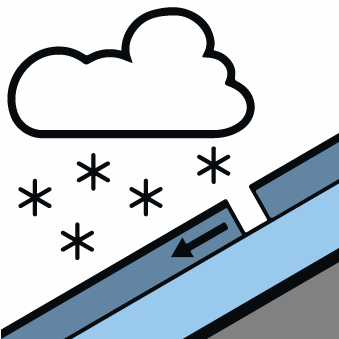
Danger level
 | 2600m
|
Avalanche Problem

New snow and gliding snow are to be critically assessed. Exposed parts of transportation routes can be endangered.
A precarious avalanche situation will be encountered over a wide area. On steep grassy slopes wet and gliding avalanches are to be expected at any time, even very large ones in isolated cases. This applies in all aspects below approximately 2600 m.
The new snow and wind slabs of the last few days can be released easily, even by a single winter sport participant, in all aspects above the tree line. The number and size of avalanche prone locations will increase with altitude. With the end of the intense precipitation, the natural avalanche activity will gradually decrease [Emtpy].
The current avalanche situation calls for very extensive experience in the assessment of avalanche danger and great restraint.
Snowpack
dp.2: gliding snow
dp.6: cold, loose snow and wind
Over a wide area 120 to 180 cm of snow, and even more in some localities, has fallen since Friday. 5 to 15 cm of snow will fall on Monday. Over a wide area moderate southeasterly wind. The sometimes storm force wind has transported a lot of snow. In many cases new snow and wind slabs are lying on soft layers. This applies at high altitudes and in high Alpine regions. The rain gave rise on Sunday to a loss of strength within the snowpack especially at low and intermediate altitudes.
Tendency
Further decrease in avalanche danger. Caution is to be exercised in areas with glide cracks.
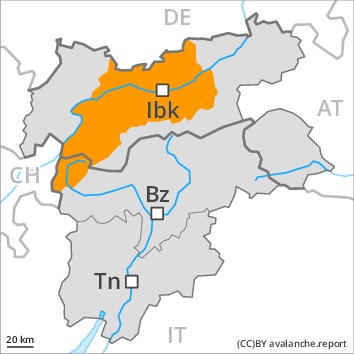
Danger level
 | 2600m
|
Avalanche Problem
 | | Gliding snow |
|  | |  |
 | | Wind-drifted snow |
|  | |  |

Wind slabs and gliding snow require caution.
On steep grassy slopes wet and gliding avalanches are to be expected, in particular medium-sized ones. This applies in all aspects below approximately 2600 m.
In addition the extensive wind slabs of the last few days above the tree line are easily triggered. The number and size of avalanche prone locations will increase with altitude. The current avalanche situation calls for experience in the assessment of avalanche danger. In the regions exposed to heavier precipitation the avalanche danger is a little higher.
Snowpack
dp.2: gliding snow
dp.6: cold, loose snow and wind
Over a wide area 40 to 80 cm of snow, and even more in some localities, has fallen since Friday. 0 to 10 cm of snow will fall on Monday. Over a wide area moderate southeasterly wind. The sometimes storm force wind has transported a lot of snow. New snow and wind slabs are lying on soft layers. This applies at high altitudes and in high Alpine regions. The rain gave rise on Sunday to a loss of strength within the snowpack especially at low and intermediate altitudes.
Tendency
Further decrease in avalanche danger. Caution is to be exercised in areas with glide cracks.
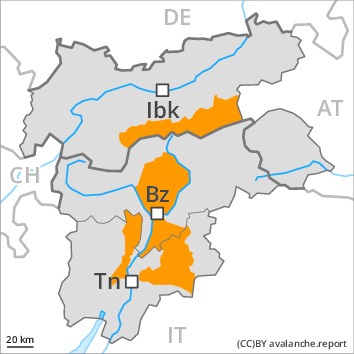
Danger level
 | 2600m
|
Avalanche Problem

Gliding snow is to be evaluated critically. Exposed parts of transportation routes can be endangered.
A precarious avalanche situation will persist in some regions. On steep grassy slopes wet and gliding avalanches are to be expected at any time, even large ones. This applies in all aspects below approximately 2600 m.
The new snow and wind slabs of the last few days can be released easily, even by a single winter sport participant, in all aspects above the tree line. The number and size of avalanche prone locations will increase with altitude. With the end of the intense precipitation, the natural avalanche activity will gradually decrease [Emtpy].
The current avalanche situation calls for extensive experience in the assessment of avalanche danger and great restraint. In the regions exposed to heavier precipitation the avalanche danger is a little higher.
Snowpack
dp.2: gliding snow
dp.6: cold, loose snow and wind
Over a wide area 80 to 130 cm of snow, and even more in some localities, has fallen since Friday. 5 to 15 cm of snow will fall on Monday. Over a wide area moderate southeasterly wind. The sometimes storm force wind has transported a lot of snow. New snow and wind slabs are lying on soft layers. This applies at high altitudes and in high Alpine regions. The rain gave rise on Sunday to a loss of strength within the snowpack especially at low and intermediate altitudes.
Tendency
Further decrease in avalanche danger. Caution is to be exercised in areas with glide cracks.

Danger level
 | treeline
|
Avalanche Problem
 | | Wind-drifted snow |
|  | |  |
 | | Gliding snow |
|  | |  |

Wind slabs and gliding snow represent the main danger.
As a consequence of new snow and a strong southerly wind, extensive wind slabs formed especially above the tree line. These are to be assessed critically, especially on steep shady slopes. Such avalanche prone locations are but are barely recognisable because of the poor visibility.
On steep grassy slopes more small to medium-sized gliding avalanches are possible below approximately 2600 m.
Snowpack
dp.6: cold, loose snow and wind
dp.2: gliding snow
Over a wide area 20 to 40 cm of snow, and even more in some localities, has fallen since Friday.
The sometimes storm force wind has transported a lot of snow. The old snowpack is weak in some cases and its surface consists of loosely bonded snow lying on a melt-freeze crust that is barely capable of bearing a load, in particular on shady slopes at high altitudes and in high Alpine regions.
Tendency
The avalanche danger will decrease gradually.
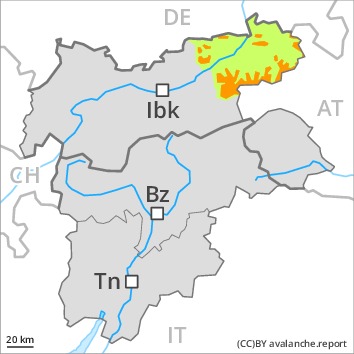
Danger level
 | 2000m
|
Avalanche Problem

Fresh wind slabs are to be evaluated with care and prudence.
As a consequence of new snow and a strong southerly wind, extensive wind slabs formed at high altitude. These are to be assessed critically. They can be released by a single winter sport participant in some cases in particular on northwest to north to northeast facing aspects. Such avalanche prone locations are but are barely recognisable because of the poor visibility.
Snowpack
dp.6: cold, loose snow and wind
dp.2: gliding snow
10 to 40 cm of snow, and even more in some localities, has fallen above approximately 2000 m. The sometimes storm force wind has transported a lot of snow. The old snowpack is weak in some cases and its surface consists of loosely bonded snow lying on a melt-freeze crust that is barely capable of bearing a load, especially on steep shady slopes at high altitudes and in high Alpine regions. At low and intermediate altitudes hardly any snow is lying.
Tendency
The avalanche danger will decrease gradually.
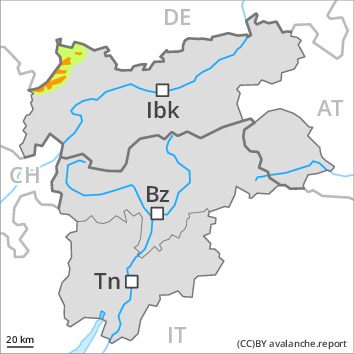
Danger level
 | 2000m
|
Avalanche Problem

Fresh wind slabs are to be evaluated with care and prudence.
As a consequence of new snow and a strong southerly wind, extensive wind slabs formed at high altitude. These are to be assessed critically. They can be released by a single winter sport participant in some cases in particular on northwest to north to northeast facing aspects. Such avalanche prone locations are but are barely recognisable because of the poor visibility.
Snowpack
dp.6: cold, loose snow and wind
dp.2: gliding snow
10 to 40 cm of snow, and even more in some localities, has fallen above approximately 2000 m. The sometimes storm force wind has transported a lot of snow. The old snowpack is weak in some cases and its surface consists of loosely bonded snow lying on a melt-freeze crust that is barely capable of bearing a load, especially on steep shady slopes at high altitudes and in high Alpine regions. At low and intermediate altitudes hardly any snow is lying.
Tendency
The avalanche danger will decrease gradually.








